Country Russia Population 592,034 (2010) | Area 600 km² Founded July 2, 1860 | |
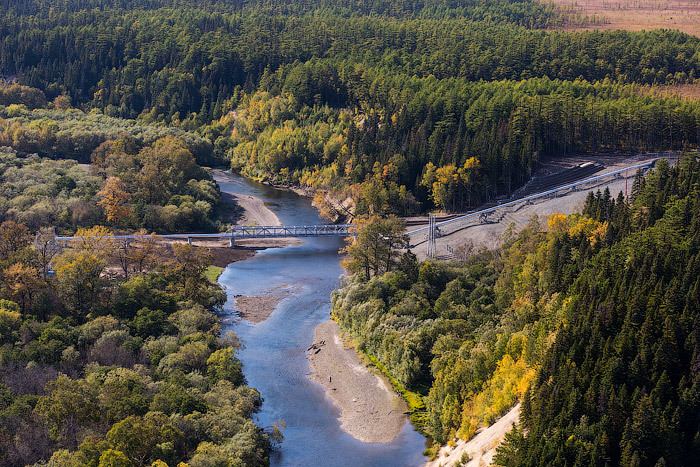 | ||
Points of interest Zolotoy Rog, Popov Island, Lazurnaya Bay Colleges and Universities Far Eastern Federal University, Vladivostok State University of Economics and Service, Vladivostok State Medical University, Far Eastern State Technical Fisheries University, Maritime State University | ||
Map of Vladivostok
Vladivostok (Russian: Владивосто́к; [vlədʲɪvɐˈstok], literally ruler of the east) is a city and the administrative centre of Primorsky Krai, Russia, located around the Golden Horn Bay, not far from Russia's borders with China and North Korea. The population of the city as of 2016 is 606,653, up from 592,034 recorded in the 2010 Russian census. The city is the home port of the Russian Pacific Fleet and the largest Russian port on the Pacific Ocean.
Contents
- Map of Vladivostok
- VLADIVOSTOK RUSSIA a day as a tourist RIPPER FILMS
- Names and etymology
- History
- Geography
- Climate
- Politics
- Administrative and municipal status
- Demographics
- Economy
- Transportation
- Urban transportation
- Port
- Education
- Media
- Theater
- Museums
- Music
- Parks and squares
- Pokrovskiy Park
- Minny Gorodok
- Detsky Razvlekatelny Park
- Admiralsky Skver
- Pollution
- Sports
- Twin towns and sister cities
- References
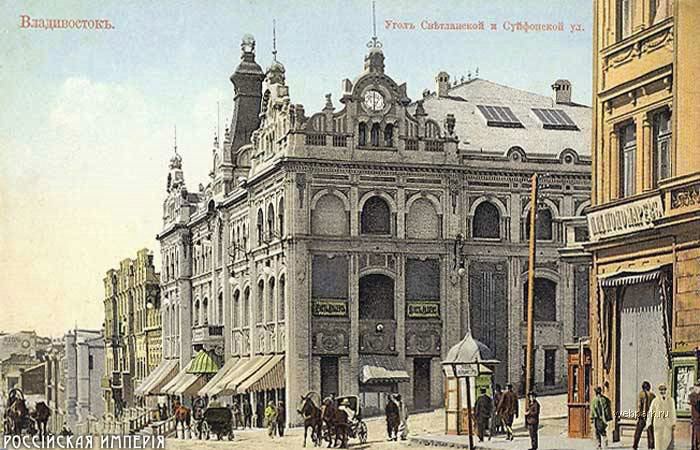
VLADIVOSTOK RUSSIA - a day as a tourist - RIPPER FILMS
Names and etymology
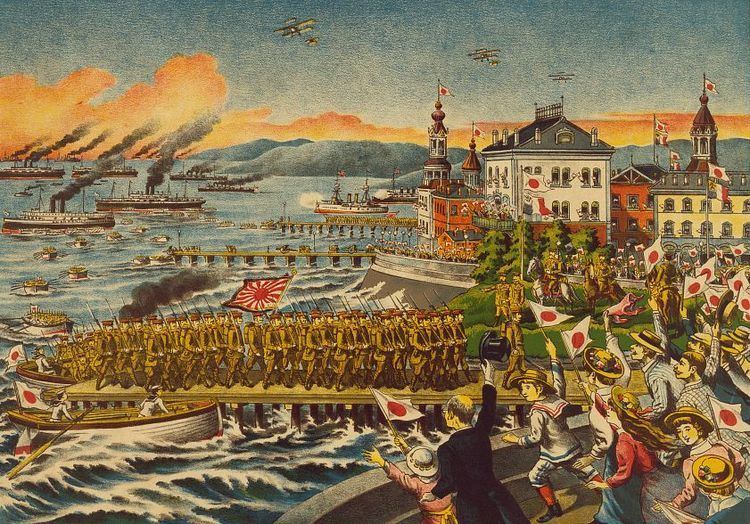
The name Vladivostok loosely translates from Russian as "ruler of the East" (imperative of the verb vladet′ [владеть] plus vostok [Восток]) —a name similar to that of the Ossetian capital of Vladikavkaz which means "ruler of the Caucasus" and which was first used in 1784. The unofficial nickname of the city is Vladik (Владик). Vladivostok was first named in 1859 along with other features in the Peter the Great Gulf area by Nikolay Muravyov-Amursky. The name first applied to the bay but, following an expedition by Alexey Shefner in 1860, was applied to the new settlement.
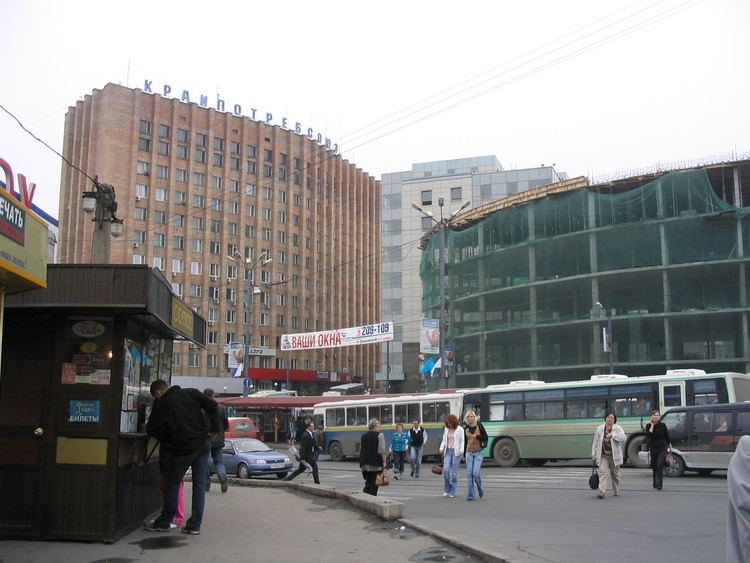
On Chinese maps from the Yuan Dynasty (1271–1368), Vladivostok was called Yǒngmíngchéng (永明城, lit. "city of eternal light").
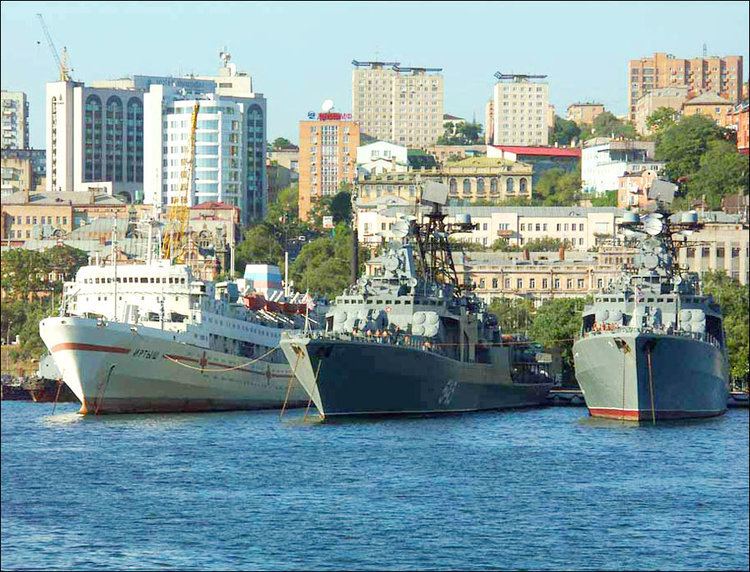
In Chinese, the place where the city is situated nowadays has been known since the Qing Dynasty as Haishenwai (海參崴, Hǎishēnwǎi}}), from the Manchu Haišenwai (Manchu: ᡥᠠᡳᡧᡝᠨᠸᡝᡳ; Möllendorff: Haišenwai; Abkai: Haixenwai) or "small seaside village". As the Manchu Qing Dynasty (1644–1911) banned Han Chinese from most of Manchuria (including the Vladivostok region), it was only visited by shēnzéi (參賊, ginseng or sea cucumber thieves) who illegally entered the area seeking ginseng or sea cucumbers (ambiguous, since both words use the Chinese 參, shēn). From this comes the current Chinese name for the city, Hǎishēnwǎi (海參崴, usually translated roughly as "sea-cucumber cliffs").
In modern-day China, Vladivostok is officially known by the transliteration Fúlādíwòsītuōkè (符拉迪沃斯托克), although the historical Chinese name Haishenwai is still often used in common parlance and outside mainland China to refer to the city.
The Japanese name of the city is Urajiosutoku (ウラジオストク; a rough transliteration of the Russian originally written in Kanji as 浦塩斯徳 and often shortened to Urajio; ウラジオ; 浦塩). In Korean, the name is transliterated as Beulladiboseutokeu (블라디보스토크) in South Korea, Ullajibosŭttokhŭ (울라지보스또크) in North Korea and China.
History
The aboriginals of the territory on which modern Vladivostok is located are the Udege minority, and a sub-minority called the Taz which emerged through members of the indigenous Udege mixing with the nearby Chinese and Hezhe. The region had been part of many states, such as the Mohe, Balhae Kingdom, Liao Dynasty, Jīn Dynasty, Yuan Dynasty, Qing Dynasty and various other Chinese dynasties, before Russia acquired the entire Maritime Province and the island of Sakhalin by the Treaty of Beijing (1860). Qing China, which had just lost the Opium War with Britain, was unable to defend the region. The Manchu emperors of China, the Qing Dynasty, banned Han Chinese from most of Manchuria including the Vladivostok area (see Willow Palisade)—it was only visited by illegal gatherers of ginseng and sea cucumbers.
On June 20 (July 2 Gregorian style), 1860, the military supply ship Manchur, under the command of Captain-Lieutenant Alexey K. Shefner, called at the Golden Horn Bay to found an outpost called Vladivostok. Warrant officer Nikolay Komarov with 28 soldiers and two non-commissioned officers under his command were brought from Nikolayevsk-on-Amur by ship to construct the first buildings of the future city.
The Manza War in 1868 was the first attempt by Russia to expel Chinese from territory it controlled. Hostilities broke out around Vladivostok when the Russians tried to shut off gold mining operations and expel Chinese workers there. The Chinese resisted a Russian attempt to take Ashold Island and in response, two Russian military stations and three Russian towns were attacked by the Chinese whom the Russians failed to oust.
An elaborate system of fortifications was erected between the 1870s and 1890s. A telegraph line from Vladivostok to Shanghai and Nagasaki was opened in 1871. That same year a commercial port was relocated to Vladivostok from Nikolayevsk-on-Amur. Town status was granted on April 22, 1880. A coat of arms, representing the Siberian tiger, was adopted in March 1883.
The first high school was opened in 1899. The city's economy was given a boost in 1916, with the completion of the Trans-Siberian Railway, which connected Vladivostok to Moscow and Europe.
After the October Revolution, the Bolsheviks took control of Vladivostok and the Trans-Siberian Railway in its entirety. During the Russian Civil War they were overthrown by the White-allied Czechoslovak Legion, who declared the city to be an Allied protectorate. Vladivostok became the staging point for the Allies' Siberian intervention, a multi-national force including Japan, the United States, and China, with the latter sending forces to protect the local Chinese community after merchant demands. The intervention ended in the wake of the collapse of the White Army and regime in 1919, with all Allied forces except the Japanese withdrawing by the end of 1920.
In April 1920, the city came under the formal governance of the Far Eastern Republic, a Soviet-backed buffer state between the Soviets and Japan. Vladivostok then became the capital of the Japanese-backed Provisional Priamurye Government, created after a White Army coup in the city in May 1921. The withdrawal of Japanese forces in October 1922 spelled the end of the enclave, with Ieronim Uborevich's Red Army taking the city on October 25, 1922.
As the main naval base of the Soviet Pacific Fleet, Vladivostok was officially closed to foreigners during the Soviet years. The city hosted the summit at which Leonid Brezhnev and Gerald Ford conducted the Strategic Arms Limitation Talks in 1974. At the time, the two countries decided quantitative limits on various nuclear weapons systems and banned the construction of new land-based ICBM launchers.
In 2012, Vladivostok hosted the 24th APEC summit. Leaders from the APEC member countries met at Russky Island, off the coast of Vladivostok. With the summit on Russky Island, the government and private businesses inaugurated resorts, dinner and entertainment facilities, in addition to the renovation and upgrading of Vladivostok International Airport. Two giant cable-stayed bridges were built in preparation for the summit, namely the Zolotoy Rog bridge over the Zolotoy Rog Bay in the center of the city, and the Russky Island Bridge from the mainland to Russky Island (currently the longest cable-stayed bridge in the world). The new campus of Far Eastern Federal University was completed on Russky Island in 2012.
Geography
The city is located in the southern extremity of Muravyov-Amursky Peninsula, which is about 30 kilometers (19 mi) long and 12 kilometers (7.5 mi) wide.
The highest point is Mount Kholodilnik, 257 meters (843 ft). Eagle's Nest Hill is often called the highest point of the city; but, with a height of only 199 meters (653 ft), or 214 meters (702 ft) according to other sources, it is the highest point of the downtown area, but not of the whole city.
Climate
Vladivostok has a monsoon influenced humid continental climate (Köppen climate classification Dwb) with warm, humid and rainy summers and cold, dry winters. Owing to the influence of the Siberian High, winters are far colder than a latitude of 43 degrees north should warrant given its low elevation and coastal location, with a January average of −12.3 °C (9.9 °F). Since the maritime influence is strong in summer, this results in a relatively cold annual climate given said latitude. Vladivostok's yearly mean of around 5 °C (41 °F) is some ten degrees lower than in cities on the French Riviera on a similar coastal latitude in Europe on the other extreme. Winters especially are around 20 °C (36 °F) colder than on the mildest coastlines this far north.
In winter, temperatures can drop below −20 °C (−4 °F) while mild spells of weather can raise daytime temperatures above freezing. The average monthly precipitation, mainly in the form of snow, is around 18.5 millimeters (0.73 in) from December to March. Snow is common during winter, but individual snowfalls are light, with a maximum snow depth of only 5 centimeters (2.0 in) in January. During winter, clear sunny days are common.
Summers are warm, humid and rainy, due to the East Asian monsoon. The warmest month is August, with an average temperature of +19.8 °C (67.6 °F). Vladivostok receives most of its precipitation during the summer months, and most summer days see some rainfall. Cloudy days are fairly common and because of the frequent rainfall, humidity is high, on average about 90% from June to August.
On average, Vladivostok receives 840 millimeters (33 in) per year, but the driest year was 1943, when 418 millimeters (16.5 in) of precipitation fell, and the wettest was 1974, with 1,272 millimeters (50.1 in) of precipitation. The winter months from December to March are dry, and in some years they have seen no measurable precipitation at all. Extremes range from −31.4 °C (−24.5 °F) in January 1931 to +33.6 °C (92.5 °F) in July 1939.
Politics
Head of the city of Vladivostok on the principles of unity of command directs the administration of the city of Vladivostok in accordance with federal laws, the laws of the Primorsky Krai, and the charter of the city. The structure of the city administration has the City Council at the top.
The responsibilities of the administration of Vladivostok are:
Legislative authority is vested in the City Council. The new City Council began operations in 2001 and on June 21, deputies of the Duma of the first convocation of Vladivostok began their work. On December 17, 2007, the Duma of the third convocation began. The deputies consist of 35 elected members, including 18 members chosen by a single constituency, and 17 deputies from single-mandate constituencies.
Administrative and municipal status
Vladivostok is the administrative center of the krai. Within the framework of administrative divisions, it is, together with five rural localities, incorporated as Vladivostok City Under Krai Jurisdiction—an administrative unit with the status equal to that of the districts. As a municipal division, Vladivostok City Under Krai Jurisdiction is incorporated as Vladivostoksky Urban Okrug.
Demographics
The population of the city, according to the 2010 Census, is 592,034, down from 594,701 recorded in the 2002 Census. This is further down from 633,838 recorded in the 1989 Census. Following the 2009 recession the population of the city has continuously increased to 606,653 as of 2016
Ethnic Russians make up the majority of the population.
Economy
The city's main industries are shipping, commercial fishing, and the naval base. Fishing accounts for almost four-fifths of Vladivostok's commercial production. Other food production totals 11%.
A very important employer and a major source of revenue for the city's inhabitants is the import of Japanese cars. Besides salesmen, the industry employs repairmen, fitters, import clerks as well as shipping and railway companies. The Vladivostok dealers sell 250,000 cars a year, with 200,000 going to other parts of Russia. Every third worker in the Primorsky Krai has some relation to the automobile import business. In recent years, the Russian government has made attempts to improve the country's own car industry. This has included raising tariffs for imported cars, which has put the car import business in Vladivostok in difficulties. To compensate, Prime Minister Vladimir Putin ordered the car manufacturing company Sollers to move one of its factories from Moscow to Vladivostok. The move was completed in 2009, and the factory now employs about 700 locals. It is planned to produce 13,200 cars in Vladivostok in 2010.
Transportation
The Trans-Siberian Railway was built to connect European Russia with Vladivostok, Russia's most important Pacific Ocean port. Finished in 1905, the rail line ran from Moscow to Vladivostok via several of Russia's main cities. Part of the railroad, known as the Chinese Eastern Line, crossed over into Manchuria, China, passing through Harbin, a major city in Manchuria. Today, Vladivostok serves as the main starting point for the Trans-Siberian portion of the Eurasian Land Bridge.
Vladivostok is the main air hub in the Russian Far East. Vladivostok International Airport (VVO) is the home base of Aurora airline - a Russian Far East air carrier, a subsidiary of Aeroflot. The airline was formed by Aeroflot in 2013 by amalgamating SAT Airlines and Vladivostok Avia. Vladivostok International Airport was significantly upgraded in 2013 with a new 3500 meter runway capable of accommodating all aircraft types without any restrictions. Terminal A was built in 2012 with capacity of 3.5 million passengers a year.
International flights connect Vladivostok with South Korea, Japan, China, North Korea , Philippines and Vietnam.
It is possible to get to Vladivostok from several of the larger cities in Russia. Regular flights to Seattle, Washington, were available in the 1990s but have been canceled since. Vladivostok Air was flying to Anchorage, Alaska, from July 2008 to 2013 before its transformation into Aurora airline.
Vladivostok is the starting point of Ussuri Highway (M60) to Khabarovsk, the easternmost part of Trans-Siberian Highway that goes all the way to Moscow and Saint Petersburg via Novosibirsk. The other main highways go east to Nakhodka and south to Khasan.
Urban transportation
On June 28, 1908, Vladivostok's first tram line was started along Svetlanskaya Street, running from the railway station on Lugovaya Street. On October 9, 1912, the first wooden cars manufactured in Belgium entered service. Today, Vladivostok's means of public transportation include trolleybus, bus, tram, train, funicular, and ferryboat. The main urban traffic lines are City Center—Vtoraya Rechka, City Center—Pervaya Rechka—3ya Rabochaya—Balyayeva, and City Center—Lugovaya Street.
In 2012, Vladivostok hosted the 24th Summit of the Asia-Pacific Economic Cooperation (APEC) forum. In preparation for the event, the infrastructure of the city was renovated and improved. Two giant cable-stayed bridges were constructed in Vladivostok, namely the Zolotoy Rog Bridge over the Golden Horn Bay in the center of the city, and the Russky Bridge from the mainland to Russky Island, where the summit took place. The latter bridge is the longest cable-stayed bridge in the world.
Port
The port is ice-free all year round (with the help of ice breakers), and in 2002 had a foreign trade turnover worth $275 million. In 2015, a special economic zone has been settled with the free port of Vladivostok.
Education
Vladivostok is home to numerous educational institutions, including five universities:
The Presidium of the Far Eastern Division of the Russian Academy of Sciences (ДВО РАН) as well as ten of its research institutes are also located in Vladivostok, as is the Pacific Research Institute of Fisheries and Oceanography (Тихоокеанский научно-исследовательский рыбохозяйственный центр or ТИНРО).
Media
Over fifty newspapers and regional editions to Moscow publications are issued in Vladivostok. The largest newspaper of the Primorsky Krai and the whole Russian Far East is Vladivostok News with a circulation of 124,000 copies at the beginning of 1996. Its founder, joint-stock company Vladivostok-News, also issues a weekly English-language newspaper Vladivostok News. The subjects of the publications issued in these newspapers vary from information about Vladivostok and Primorye, to major international events. Newspaper Zolotoy Rog (Golden Horn) gives every detail of economic news. Entertainment materials and cultural news constitute a larger part of Novosti (News) newspaper which is the most popular among Primorye's young people. Also, new online mass media about the Russian Far East for foreigners is the Far East Times. This source invites readers to take part in informational support of R.F.E. for visitors, travelers and businessmen. Vladivostok operates many online media outlets - newsvl, primamedia, and primorye24.
As of 1999, there are also seven radio stations, the most popular being 24-hour VBC (612 kHz, 101.7 MHz) and Europa+ (738 kHz, 104.2 MHz). Europa+ normally broadcasts popular modern British-American music, while the ratio of Russian and foreign songs over VBC is fifty-fifty. Every hour one can hear local news over these radio stations. Radio Vladivostok (1098 kHz) operates from 06:00 till 01:00. It broadcasts several special programs which are devoted to the music of the 1950s-1980s as well as new-age.
It is the nearest city to the massive Sikhote-Alin Meteorite, which fell on February 12, 1947 in the Sikhote-Alin Mountains, approximately 440 kilometres (273 miles) northeast of Vladivostok.
Theater
Maxim Gorky Academic Theater, named after the Russian author Maxim Gorky, was founded in 1931 and is used for drama, musical and children's theater performances.
In September 2012, a granite statue of the actor Yul Brynner (1920–1985) was inaugurated in Yul Brynner Park, directly in front of the house where he was born at 15 Aleutskaya St.
Museums
The Arsenyev Primorye Museum (Приморский государственный объединенный музей имени В.К. Арсеньева), opened in 1890, is the main museum of the Primorsky Krai. Besides the main facility, it has three branches in Vladivostok itself (including Arsenyev's Memorial House), and five branches elsewhere in the state. Among the items in the museum's collection are the famous 15th-century Yongning Temple Steles from the lower Amur.
Music
The city is home to the Vladivostok Pops Orchestra.
Russian rock band Mumiy Troll hails from Vladivostok and frequently puts on shows there. In addition, the city had played host to the now legendary "VladiROCKstok" International Music Festival in September 1996. Hosted by the Mayor and Governor, and organized by two young American expatriates, the festival drew nearly 10,000 people and top-tier musical acts from St. Petersburg (Akvarium and DDT) and Seattle (Supersuckers, Goodness), as well as several leading local bands. Nowadays there is another annual music festival in Vladivostok - Vladivostok Rocks. V-ROX (Vladivostok Rocks) – International Music Festival and Conference It’s a 3-day open-air city festival that claims Vladivostok as an international artistic beacon of the Asia Pacific area. Music festival and international conference of music industry and contemporary cultural management. The unique opportunity for aspiring artists and producers to gain exposure to new audiences as well as leading international professionals.
The Russian Opera House houses the State Primorsky Opera and Ballet Theater.
Parks and squares
Parks and squares in Vladivostok include Pokrovskiy Park, Minnyy Gorodok, Detskiy Razvlekatelnyy Park, Park of Sergeya Lazo, Admiralskiy Skver, Skver im. Neveskogo, Nagornyy Park, Skver im. Sukhanova, Fantaziya Park, Skver Rybatskoy Slavy, Skver im. A.I.Shchetininoy.
Pokrovskiy Park
Pokrovskiy Park was once a cemetery. Converted into a park in 1934 but was closed in 1990. Since 1990 the land the park sits on belongs to the Russian Orthodox Church. During the rebuilding of the Orthodox Church, graves were found.
Minny Gorodok
Minny Gorodok is a 91 acres (37 ha) public park. Minny Gorodok means Mine Borough Park in English. The park is a former military base that was founded in 1880. The military base was used for storing mines in underground storage. Converted into a park in 1985, Minny Gorodok contains several lakes, ponds, and an ice-skating rink.
Detsky Razvlekatelny Park
Detsky Razvlekatelny Park is a children's amusement park located near the center of the city. The park contains a carousel, gaming machines, a Ferris wheel, cafés, an aquarium, cinema, and a stadium.
Admiralsky Skver
Admiralsky Skver is a landmark located near the city's center. The Square is an open space, dominated by the Triumfalnaya Arka. South of the square sits a museum of Soviet submarine S-56.
Pollution
Local ecologists from the Ecocenter organization have claimed that much of Vladivostok's suburbs are polluted and that living in them can be classified as a health hazard. The pollution has a number of causes, according to Ecocenter geo-chemical expert Sergey Shlykov. Vladivostok has about eighty industrial sites, which may not be many compared to Russia's most industrialized areas, but those around the city are particularly environmentally unfriendly, such as shipbuilding and repairing, power stations, printing, fur farming and mining. In addition, Vladivostok has a particularly vulnerable geography which compounds the effect of the pollution. Winds cannot clear pollution from some of the most densely populated areas around the Pervaya and Vtoraya Rechka as they sit in basins which the winds blow over. In addition, there is little snow in winter and no leaves or grass to catch the dust to make it settle down.
Sports
Vladivostok is home to the football club FC Luch-Energiya Vladivostok, who plays in the Russian First Division, ice hockey club Admiral Vladivostok from the Kontinental Hockey League's Chernyshev Division, and basketball club Spartak Primorye, who plays in the Russian Basketball Super League. Vladivostok is also home to the Wild Pandas who is the bases for the development of American football across the far east of Russia.
Twin towns and sister cities
Vladivostok is twinned with:
In 2010, arches with the names of each of Vladivostok's twin towns were placed in a park within the city.
